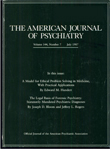Somatization in cross-cultural perspective: a World Health Organization study in primary care
Abstract
OBJECTIVE: The purpose of this study was to examine the phenomenon of somatization in different cultures by determining its frequency and correlates in primary care settings in 14 countries. METHOD: Consecutive primary care patients (N = 25,916) were screened with the 12-item General Health questionnaire, and a stratified sample (N = 5,438) was interviewed with the Composite International Diagnostic Interview. Interviewed patients were also assessed for physical disease burden, self-rated overall health, physician-rated physical health status, number of disability days, and interviewer-rated occupational role functioning. The authors determined center-specific associations with the use of logistic regression analyses in which confounding variables were controlled. RESULTS: ICD-10 defined somatization disorder was relatively uncommon in most primary care settings. A less restrictively defined form was more common. Symptom rates were much higher in South American sites. There was a modest association with low education. Otherwise, frequency of unexplained somatic symptoms did not clearly vary according to geography or level of economic development. Somatizing patients were at elevated risk for self-reported disease burden, negative perception of their health, and comorbid depression and generalized anxiety disorder. Somatization was also commonly associated with disability. Cultures did not differ markedly in the pattern of these associated features. CONCLUSION: Somatization is a common problem in primary care across cultures and is associated with significant problems and disability.



